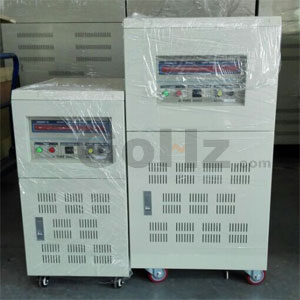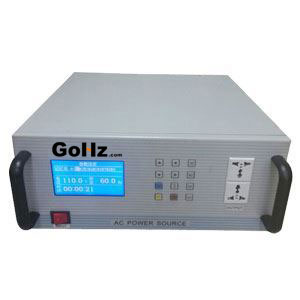What happens if frequency is changed from 50Hz to 60Hz?
In general with a small inverter rated motor, provided the current is less than the rated full load amps, it can be run over a very wide range. This has the net result that the motor has a fixed torque limit over all speeds, hence the available shaft power varies with speed, so a 5kw 50Hz motor can deliver 4kw at 40Hz, and 6kw when the frequency change to 60Hz.
As the heat in the motor varies with the load current squared, most practitioners will simple derate the motor slightly. For example if you have a 4kw mechanical load, then use a 5kw 60hz motor, and simply tell the variable frequency drive the FLA is 5/6 of the nameplate amps. The heat in the motor will be 25/36 of its 5kW rating or 69.4%, this massive reduction in heat load will enable trouble free operation from standstill to nearly twice nameplate rpm. It's a simple solution: change to the next size up motor. The difference in cost is probably less than the cost of an hour of your time anguishing over what to do.
All loads are not speed dependable. Pumps and fans typically are so called variable torque loads, so less speed usually means also less load, and this is good if motor are self-cooled. Lighter load does not then require so much cooling.
But that is not always a case, some loads can have full current drawn even in half of motor nominal speed. These are so called constant torque applications. Usually these type of applications motors have external cooling fan.
If an application is draw, let's say 75 % current at 1/2 of motor nominal speed e.g. 25 Hz, and motor is self-cooled, I guarantee that motor will heat up in that speed point with such load, it would be okay at 50 Hz, because it is rated to that.
If the load is a fan or centrifugal pump, then no special precautions are required, as the non-linear load matches the non-linear cooling.
When the output frequency is below 50Hz the output voltage is reduced usually in a linear relationship below the line voltage (say 415V). This means that less power is available to the motor (the maximum current remains the same but the voltage is reduced). Some drives have a torque boost mode that means full line voltage is achieved at frequencies lower than 50Hz. The drive manual will detail this relationship and the settings that can be used to influence it.
As the heat in the motor varies with the load current squared, most practitioners will simple derate the motor slightly. For example if you have a 4kw mechanical load, then use a 5kw 60hz motor, and simply tell the variable frequency drive the FLA is 5/6 of the nameplate amps. The heat in the motor will be 25/36 of its 5kW rating or 69.4%, this massive reduction in heat load will enable trouble free operation from standstill to nearly twice nameplate rpm. It's a simple solution: change to the next size up motor. The difference in cost is probably less than the cost of an hour of your time anguishing over what to do.
All loads are not speed dependable. Pumps and fans typically are so called variable torque loads, so less speed usually means also less load, and this is good if motor are self-cooled. Lighter load does not then require so much cooling.
But that is not always a case, some loads can have full current drawn even in half of motor nominal speed. These are so called constant torque applications. Usually these type of applications motors have external cooling fan.
If an application is draw, let's say 75 % current at 1/2 of motor nominal speed e.g. 25 Hz, and motor is self-cooled, I guarantee that motor will heat up in that speed point with such load, it would be okay at 50 Hz, because it is rated to that.
If the load is a fan or centrifugal pump, then no special precautions are required, as the non-linear load matches the non-linear cooling.
When the output frequency is below 50Hz the output voltage is reduced usually in a linear relationship below the line voltage (say 415V). This means that less power is available to the motor (the maximum current remains the same but the voltage is reduced). Some drives have a torque boost mode that means full line voltage is achieved at frequencies lower than 50Hz. The drive manual will detail this relationship and the settings that can be used to influence it.
I have a motor for 380-420/50/3 and 440-480/60/3. Can I run this motor at 400/60/3 without any problems?
Post a Comment:
You may also like:
50Hz 60Hz Frequency Converter Setting
Using GoHz frequency converter to
Or customize your own converters.
- Convert 220v 50Hz to 110v 60Hz,
- Convert 120v 60Hz to 230v 50Hz,
- Convert 110v 60Hz to 240v 50Hz,
- Convert 480v 60Hz to 380v 50Hz,
- Convert 400v 50Hz to 460v 60Hz,
- Convert 240v 60Hz to 380v 50Hz,
Or customize your own converters.
Featured Articles
460v 60Hz motor on 400v 50Hz power ...
 Often the European motors at 1hp size are universal for 50Hz or 60Hz power supply, as long as you have 400V x 50Hz and 460V x ...
Often the European motors at 1hp size are universal for 50Hz or 60Hz power supply, as long as you have 400V x 50Hz and 460V x ...
 Often the European motors at 1hp size are universal for 50Hz or 60Hz power supply, as long as you have 400V x 50Hz and 460V x ...
Often the European motors at 1hp size are universal for 50Hz or 60Hz power supply, as long as you have 400V x 50Hz and 460V x ...Convert 220v, 230v, 240v 50Hz to 110v, ...
 When you buy an 110v (120v) 60Hz appliance from USA, and run it on 220v (230v, 240v) 50Hz country (i.e. UK, Australia, ...
When you buy an 110v (120v) 60Hz appliance from USA, and run it on 220v (230v, 240v) 50Hz country (i.e. UK, Australia, ...
 When you buy an 110v (120v) 60Hz appliance from USA, and run it on 220v (230v, 240v) 50Hz country (i.e. UK, Australia, ...
When you buy an 110v (120v) 60Hz appliance from USA, and run it on 220v (230v, 240v) 50Hz country (i.e. UK, Australia, ...60Hz motor running on 50Hz power ...
 Electric motors, both single and three phase, are designed for running on a specified power frequency. But sometimes we may use a ...
Electric motors, both single and three phase, are designed for running on a specified power frequency. But sometimes we may use a ...
 Electric motors, both single and three phase, are designed for running on a specified power frequency. But sometimes we may use a ...
Electric motors, both single and three phase, are designed for running on a specified power frequency. But sometimes we may use a ...